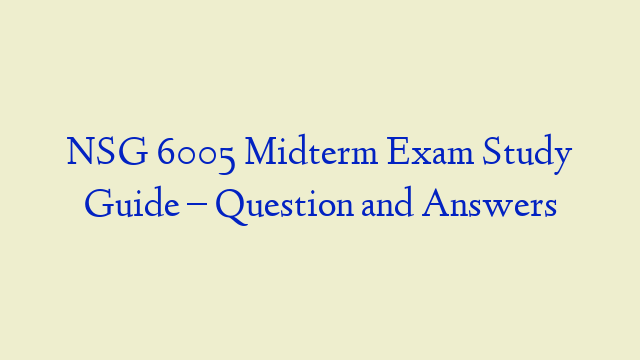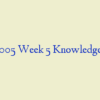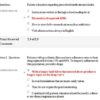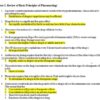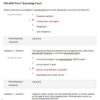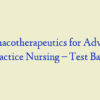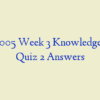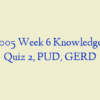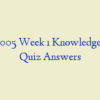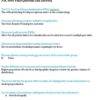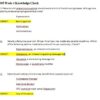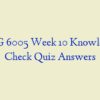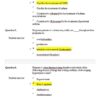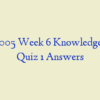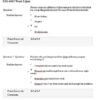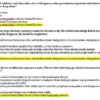Description
NSG 6005 Midterm Exam – Question and Answers
- The first-line treatment for cough related to a upper respiratory infection in a five-year-old is:
- Pregnant patients with asthma may safely use ____ throughout their pregnancies.
- A stepwise approach to the pharmacologic management of asthma:
- Infants with reflux are initially treated with:
- Many patients self-medicate with antacids. Which patients should be counseled to not take calcium carbonate antacids without discussing with their providers or a pharmacist first?
- Second-generation antihistamines such as loratadine (Claritin) are prescribed for seasonal allergies because they:
- Decongestants such as pseudoephedrine (Sudafed):
- Patients with pheochromocytoma should avoid which of the following classes of drugs due to the possibility of developing hypertensive crisis?
- Education of patients with COPD who use inhaled corticosteroids includes the following:
- Monitoring a patient with persistent asthma includes:
- Harold, a forty-two-year-old African American, has moderate persistent asthma. Which of the following asthma medications should he use cautiously, if at all?
- When prescribing montelukast (Singulair) for asthma, patients or parents of patients should be instructed as follows:
- Lifestyle changes are the first step in the treatment of GERD. Foods that may aggravate GERD include:
- Christy has exercise and mild persistent asthma and is prescribed two puffs of albuterol fifteen minutes before exercise and as needed for wheezing. One puff per day of beclomethasone (Qvar) is also prescribed. Teaching regarding her inhalers includes which one of the following?
- One goal of asthma therapy outlined by the NHLBI Expert Panel 3 guidelines is:
- Treatment failure in patients with PUD associated with H. pylori may be due to:
- When using the “step-up” approach in caring for a patient with GERD, the “step up” from OTC antacid use is:
- Long-term use of PPIs may lead to:
- Art is a fifty five year old smoker who has been diagnosed with angina and placed on nitrates. He complains of headaches after using his nitrate. An appropriate reply might be:
- . In teaching about the use of sublingual nitroglycerine, the patient should be instructed:
- A potentially life-threatening adverse response to ACE inhibitors is angioedema. Which of the following statements is true about this adverse response?
- Patients who are being treated for folate deficiency require monitoring of:
- Treatments for heart failure, including drug therapy, are based on the stages developed by the American Heart Association and the American College of Cardiology. Stage A patients are:
- Furosemide is added to a treatment regimen for heart failure, which includes digoxin. Monitoring for this combination includes:
- Isosorbide dinitrate is a long-acting nitrate given twice daily (BID). The schedule for administration is 7 a.m. and 2 p.m. because:
- The New York Heart Association and the Canadian Cardiovascular Society have described grading criteria for levels of angina. Angina that occurs with unusually strenuous activity or on walking or climbing stair after meals is:
- Kyle has Crohn’s disease and has a documented folate deficiency. Drug therapy for folate deficiency anemia is:
- The American Heart Association and the American College of Cardiology have devised a classification system for heart failure that can be used to direct treatment. Patients with symptoms and underlying disease are classified as:
- Disease states in addition to hypertension in which beta blockade is a compelling indication for the use of beta blockers include:
- Which of the following classes of drugs is contraindicated in heart failure?
- Which of the following is true about procainamide and its dosing schedule?
- At which stage/classification of hypertension should drug therapy be instituted according to the JNC-7 Report?
- Jose is a twelve-year-old overweight child with a total cholesterol level of 180 mg/dL and LDL of 125 mg/dL. Along with diet education and recommending increased physical activity, a treatment plan for Jose would include ____ with a reevaluation in six months.
- Patients who have angina, regardless of class, who are also diabetic should be on:
- If not chosen as the first drug in hypertension treatment, which drug class should be added as the second step because it will enhance the effects of most other agents?
- Donald has been diagnosed with hyperlipidemia. On the basis of his lipid profile, atorvastatin is prescribed. Rhabdomyolysis is a rare but serious adverse response to this drug. Donald should be told to:
- 2ND LINE TX FOR GERD: quadruple therapy – 2nd line therapy for those who fail treatment initially is the PPI twice a day plus metronidazole plus tetracycline plus bismuth subsalicylate for 14 days
- How will you choose a diuretic in the treatment of hypertension?:- Check kidney function, thiazide diuretic need to have a GFR higher than the mid 40 mL/min range…
- After H. pylori treatment is completed, the next step in peptic ulcer disease therapy is::1. Testing for H. pylori eradication with a serum ELISA test
- .Angela is a 5-year-old patient who presents to the clinic with a 48-hour history of nausea, vomiting, and some diarrhea. She is unable to keep fluids down and her weight is 4 pounds less than her last recorded weight. Besides IV fluids, her exam warrants the use of an antinausea medication. Which of the following would be the appropriate drug to order for Angela?:
- Antacid’s
- Decongestants such as pseudoephedrine (Sudafed)::
- .Flovent:
- .How are upper respiratory infections treated?: –
- Phenylephrine can be useful for patients with symptomatic relief in adults without
- If a patient with H. pylori-positive peptic ulcer disease fails first-line therapy, the second-line treatment is::
- .If a patient with symptoms of gastroesophageal reflux disease states that he has been self-treating at home with OTC ranitidine daily, the appropriate treatment would be::
- Jaide will be traveling to Mexico with her church group over spring break to build houses. She is concerned she may develop traveler’s diarrhea. Advice includes following normal food and water precautions as well as taking::
- Mech of action for muscarinic antagonist:
- Metoclopramide improves gastroesophageal reflux disease symptoms by::
- Michelle is a 72-year-old patient who takes omeprazole for her chronic GERD. Chronic long-term omeprazole use places her at increased risk for::
- Misoprostol should not be given to:
- Patients on digioxin and albuterol should have what checked?:
- Patients who are on chronic long-term proton pump inhibitor therapy require monitoring for::
- Reglan (metoclopramide):
- Richard is a 10-year-old patient who presents with uncomfortable constipation. Along with diet changes, a laxative is ordered to provide more rapid relief of constipation. An appropriate choice of medication for a 10-year-old child would be::
- Stan, a 42-year-old African American, has moderate persistent asthma. Which of the following asthma medications should be used cautiously, if at all?:
- Tiotropium bromide (Spiriva) is an inhaled anticholinergic::
- Treatment failure in patients with peptic ulcer disease associated with H. pylori may be because of::
- What are the disadvantages of using stimulant laxatives for prolonged periods of time?:-
- What conditions should cause a patient to avoid the use of antihistamines?:
- .What do H2 blockers do?:
- What do PPI’s do?:
- What ethnic background should not be prescribed long-acting beta agonists?:
- What is the first line therapy for peptic ulcer disease with a positive H. pylori?:-
- What is the mechanism of action of codeine in the suppression of cough?:
- What is the mechanism of action of docusate sodium?:-
- What is the mechanism of action of ondansetron?:-
- What is the mechanism of action of the phenothiazine antiemetics?:
- What is the Step Down Approach with GERD?:
- What is the Step Up Approach with GERD?:-
- Asthma exacerbations at home are managed by the patient by:
- Howard is a seventy-two-year-old male who occasionally takes diphenhydramine for his seasonal allergies. Monitoring for this patient taking diphenhydramine would include assessing for:
- A patient with a COPD exacerbation may require
- Decongestants such as pseudoephedrine (Sudafed):
- An acceptable first-line treatment for PUD disease with positive H. pylori test is:
- In five- to eleven-year-old children, mild-persistent asthma is diagnosed when asthma symptoms occur:
- When treating a patient using the “step-down” approach, the patient with GERD is started on ____ first
- Monitoring a patient with persistent asthma includes:
- Patients with pheochromocytoma should avoid which of the following classes of drugs due to the possibility of developing hypertensive crisis?
- Metoclopramide improves GERD symptoms by:
- Patients who are on chronic long-term PPI therapy require monitoring for:
- Digoxin levels need to be monitored closely when the following medication is started:
- Patients with pheochromocytoma should avoid which of the following classes of drugs because of the possibility of developing hypertensive crisis?
- Stan, a 42-year-old African American, has moderate persistent asthma. Which of the following asthma medications should be used cautiously, if at all?
- Long-acting beta-agonists (LTBAs) received a Black Box Warning from the U.S. Food and Drug Administration due to the:
- The bronchodilator of choice for patients taking propranolol is:
- Mathew is a 52-year-old overweight smoker taking theophylline for his persistent asthma. He tells his provider he is going to start the Atkin’s diet for weight loss. The appropriate response would be:
- Marty takes theophylline for his persistent asthma and calls the office with a complaint of nausea, vomiting, and headache. The best advice for him would be to:
- Tiotropium bromide (Spiriva) is an inhaled anticholinergic:
- Angela has exercise-induced and mild persistent asthma and is prescribed two puffs of albuterol 15 minutes before exercise and as needed for wheezing. One puff per day of beclomethasone (QVAR) is also prescribed. Teaching regarding her inhalers includes:
- When educating patients who are starting on inhaled corticosteroids, the provider should tell them that:
- Patients with allergic rhinitis may benefit from a prescription of:
- William is a 72-year-old male who occasionally takes diphenhydramine for his seasonal allergies. Monitoring for this patient taking diphenhydramine would include assessing for:
- When recommending dimenhydrinate (Dramamine) to treat motion sickness, patients should be instructed to:
- Cough and cold medications that contain a sympathomimetic decongestant such as phenylephrine should be used cautiously in what population:
- George is a 60-year-old patient with hypertension. The first-line decongestant to prescribe would be:
- Prior to developing a plan for the treatment of asthma, the patient’s asthma should be classified according to the NHLBI Expert Panel 3 guidelines. In adults, mild-persistent asthma is classified as asthma symptoms that occur:
- In children age 5 to 11 years mild-persistent asthma is diagnosed when asthma symptoms occur:
- One goal of asthma therapy outlined by the NHLBI Expert Panel 3 guidelines is:
- Treatment for mild intermittent asthma is:
- The first-line therapy for mild-persistent asthma is:
- Monitoring a patient with persistent asthma includes:
- Asthma exacerbations at home are managed by the patient by:
- Patients who are at risk of a One of the three types of heart failure involves systolic dysfunction. Potential causes of this most common form of heart failure include:
- One goal of asthma management in children is:
- Medications used in the management of patients with chronic obstructive pulmonary disease (COPD) include:
- Patients with a COPD exacerbation may require:
- Patients with COPD require monitoring of:
- Education for patients who use an inhaled beta-agonist and an inhaled corticosteroid includes:
- The most common bacterial pathogen in community-acquired pneumonia is
- The first-line drug choice for a previously healthy adult patient diagnosed with community-acquired pneumonia would be:
- The first-line antibiotic choice for a patient with comorbidities or who is immunosuppressed who has pneumonia and can be treated as an outpatient would be
- If an adult patient with comorbidities cannot reliably take oral antibiotics to treat pneumonia, an appropriate initial treatment option would be:
- Jennifer is 34 weeks pregnant and has been diagnosed with pneumonia. She is stable enough to be treated as an outpatient. What would be an appropriate antibiotic to prescribe?
- Adults with pneumonia who are responding to antimicrobial therapy should show improvement in their clinical status in:
- Along with prescribing antibiotics, adults with pneumonia should be instructed on lifestyle modifications to improve outcomes, including:
- Liam is a 4-week-old infant who has been diagnosed with chlamydial pneumonia. An appropriate treatment for his pneumonia would be:
- Charlie is a 4-year-old patient who has suspected bacterial pneumonia. He has a temperature of 102°F, oxygen saturation level of 95%, and is taking fluids adequately. What would be appropriate initial treatment for his pneumonia?
- Bailey is a 14-year-old patient who presents to the clinic with symptoms consistent with mycoplasma pneumonia. What is the treatment for suspected mycoplasma pneumonia in an adolescent?
- Drug resistant tuberculosis (TB) is defined as TB that is resistant to:
- Goals when treating tuberculosis include:
- The principles of drug therapy for the treatment of tuberculosis include:
- Lilliana has confirmed tuberculosis and is placed on a 6-month treatment regimen. The 6-month regimen consists of:
- Jordan has extensively resistant tuberculosis (TB). Treatment for extensively resistant TB would include:
- Sunny is 24 weeks pregnant and has been diagnosed with tuberculosis (TB). Treatment regimens for a pregnant patient with TB would include:
- Lola is a 5-year-old patient who has been diagnosed with tuberculosis. His treatment would include:
- Frankie is a 9-year-old patient who lives in a household with a family member newly diagnosed with tuberculosis (TB). To prevent Ezekiel from developing TB he should be treated with:
- Cidney is completing a 6-month regimen to treat tuberculosis (TB). Monitoring of a patient on TB therapy includes:
- Compliance with directly observed therapy can be increased by:
- Patients taking antacids should be educated regarding these drugs, including letting them know that:
- Charlotte has diarrhea and is wondering if she can take loperamide (Imodium) for the diarrhea. Loperamide:
- Bismuth subsalicylate (Pepto Bismol) is a common OTC remedy for gastrointestinal complaints. Bismuth subsalicylate:
- Joe presents with complaints of “heartburn” that is minimally relieved with Tums (calcium carbonate) and is diagnosed with gastroesophageal reflux disease (GERD). An appropriate first-step therapy would be:
- Patients who are on chronic long-term proton pump inhibitor therapy require monitoring for:
- Michelle is a 72-year-old patient who takes omeprazole for her chronic GERD. Chronic long-term omeprazole use places her at increased risk for:
- Richard is a 10-year-old patient who presents with uncomfortable constipation. Along with diet changes, a laxative is ordered to provide more rapid relief of constipation. An appropriate choice of medication for a 10-year-old child would be:
- Methylnaltrexone is used to treat constipation in:
- An elderly person has been prescribed lactulose for treatment of chronic constipation. Monitoring with long-term treatment would include:
- Gastroesophageal reflux disease may be aggravated by the following medication that affects lower esophageal sphincter (LES) tone:
- Lifestyle changes are the first step in treatment of gastroesophageal reflux disease (GERD). Food or drink that may aggravate GERD include:
- Metoclopramide improves gastroesophageal reflux disease symptoms by:
- Antacids treat gastroesophageal reflux disease by:
- When treating patients using the “Step-Down” approach the patient with gastroesophageal reflux disease is started on _______ first.
- If a patient with symptoms of gastroesophageal reflux disease states that he has been self-treating at home with OTC ranitidine daily, the appropriate treatment would be:
- If a patient with gastroesophageal reflux disease who is taking a proton pump inhibitor daily is not improving, the plan of care would be:
- The next step in treatment when a patient has been on proton pump inhibitors twice daily for 12 weeks and not improving is:
- Long-term use of proton pump inhibitors may lead to:
- An acceptable first-line treatment for peptic ulcer disease with positive H. pylori test is:
- Treatment failure in patients with peptic ulcer disease associated with H. pylori may be because of:
- If a patient with H. pylori-positive peptic ulcer disease fails first-line therapy, the second-line treatment is:
- After H. pylori treatment is completed, the next step in peptic ulcer disease therapy is:
- The treatment goals when treating urinary tract infection (UTI) include:
- Janis is a 16-year-old female with a urinary tract infection. She is healthy, afebrile, with no use of antibiotics in the previous 6 months and no drug allergies. An appropriate first-line antibiotic choice for her would be:
- Laurel is a 24-year-old female with a urinary tract infection. She is healthy, afebrile, and her only drug allergy is sulfa, which gives her a rash. An appropriate first-line antibiotic choice for her would be:
- Karina is a 28-year-old pregnant woman at 38 weeks’ gestation who is diagnosed with a lower urinary tract infection (UTI). She is healthy with no drug allergies. Appropriate first-line therapy for her UTI would be:
- Which of the following patients may be treated with a 3-day course of therapy for their urinary tract infection?
- Carmin is a 4-year-old female with a febrile urinary tract infection (UTI). She is generally healthy and has no drug allergies. Appropriate initial therapy for her UTI would be:
- Monitoring for a healthy, non-pregnant adult patient being treated for a urinary tract infection is:
- Monitoring for a child who has had a urinary tract infection is:
- Monitoring for a pregnant woman who has had a urinary tract infection is:
- Along with an antibiotic prescription, lifestyle education for a non-pregnant adult female who has had a urinary tract infection includes:
- Cheryl a is a healthy non-pregnant adult woman who recently had a urinary tract infection (UTI). She is asking about drinking cranberry juice to prevent a recurrence of the UTI. The correct answer to give her would be:
- Furosemide is added to a treatment regimen for heart failure that includes digoxin. Monitoring for this combination includes:
- What assessments should be made before prescribing any antihypertensive agent?
- Why are ACE inhibitors the drug of choice in diabetic patients with hypertension?
- What is the drug of choice to improve symptoms for patients taking propranolol?
- What is the most common adverse effect of an ACE inhibitor?
- What is the action of an ACE inhibitor?
- What is the action of an Angiotensin Receptor Blocker?
- What ethnic background should not be prescribed long-acting beta-agonists?
- What is tiotropium used to treat?
- What is the action of a Calcium Channel Blocker?
- What are the adverse effects of a dihydropyridine-type calcium channel blocker?
- A 70-year-old patient is admitted with peripheral edema. He is taking a calcium channel blocker and metformin. What is the cause of his peripheral edema?
- What special populations should not be prescribed pseudoephedrine?
- How is amlodipine metabolized?
- A patient is prescribed amlodipine. She develops reflex tachycardia. What is the reason for the development of bradycardia?
- What drug should be prescribed for a patient with nasal congestion with hypertension?
- What patient teaching will you provide when prescribing amiodarone?
- What are the drug interactions with digoxin?
- What is the purpose of a thyroid panel with amiodarone what is nitrate tolerance?
- What are the adverse effects of statins.
- What is nitrate tolerance?
- What are the adverse effects of antihistamines?
- What patient education will you provide for a client in which you have prescribed a statin
- How will you choose a diuretic in the treatment of hypertension?
- What are the central nervous system adverse effects with montelukast (Singular)?
- Ray has been diagnosed with hypertension and an ACE inhibitor is determined to be needed. Prior to prescribing this drug, the NP should assess for:
- ACE inhibitors are the drug of choice in treating hypertension in diabetic patients because they:
- ACE inhibitors are useful in a variety of disorders. Which of the following statements are true about both its usefulness in the disorder and the reason for its use?
- Despite good blood pressure control, a NP might change a patient’s drug from an ACEI to an angiotensin II receptor blocker (ARB) because the ARB:
- While taken an ARB, patients need to avoid certain over-the-counter drugs without first consulting the provider because:
- Laboratory monitoring for patients on ACEIs or ARBs should include:
- Jacob has hypertension for which a calcium channel blocker has been prescribed. This drug helps control blood pressure because it:
- Which of the following adverse effects may occur due to a dihydropyridine-type calcium channel blocker?
- Patient teaching related to amlodipine includes:
- Vera, age 70, has isolated systolic hypertension. Calcium channel blocker doses for her should be:
- Larry has heart failure which is being treated with digoxin because it exhibits:
- Furosemide is added to a treatment regimen for heart failure which includes digoxin. Monitoring for this combination includes:
- Which of the following create higher risk for digoxin toxicity? Both the cause and the reason for it must be correct.
- Serum digoxin levels are monitored for potential toxicity. Monitoring should occur:
- Rodrigo has been prescribed procainamide after a myocardial infarction. He is monitored for dyspnea, jugular venous distention, and peripheral edema because they may indicate:
- Amiodarone has been prescribed in a patient with a supraventricular dysrhythmia. Patient teaching should include all of the following EXCEPT:
- The NP orders a thyroid panel for a patient on amiodarone. The patient tells the NP that he does not have thyroid disease and wants to know why the test is ordered. Which is a correct response?
- Art is a 55-year-old smoker who has been diagnosed with angina and placed on nitrates. He complains of headaches after using his nitrate. An appropriate reply might be:
- Which of the following diagnostic studies would NOT indicate a problem related to a reductase inhibitor?
- Because of the pattern of cholesterol synthesis, reductase inhibitors are given:
- Janice has elevated LDL, VLDL, and triglyceride levels. Niaspan, an extended-release form of niacin, is chosen to treat her hyperlipidemia. Due to its metabolism and excretion, which of the following labs should be monitored?
- Niaspan is less likely to cause which side effect that is common to niacin?
- Which of the following statements is true?
- Dulcea has type 2 diabetes and a high triglyceride level. She has gemfibrozil prescribed to treat her hypertriglyceridemia. A history of which of the following might contraindicate the use of this drug?
- Many patients with hyperlipidemia are treated with more than one drug. Combining a fibric acid derivative such as gemfibrozil with which of the following is not recommended? The drug and the reason must both be correct for the answer to be correct.
- Felicity has been prescribed colestipol to treat her hyperlipidemia. Unlike other anti-lipidemics, this drug:
- Because of their site of action, bile acid sequestering resins:
- Colestipol comes in a powdered form. The patient is taught to:
- The choice of diuretic to use in treating hypertension is based on:
- Digoxin levels need to be monitored closely when the following medication is started:
- Patients with pheochromocytoma should avoid which of the following classes of drugs due to the possibility of developing hypertensive crisis?
- Harold, a 42-year-old African American, has moderate persistent asthma. Which of the following asthma medications should be used cautiously, if at all?
- Long-acting beta-agonists (LTBAs) received a Black Box warning from the U.S. Food and Drug Administration due to the:
- The bronchodilator of choice for patients taking propranolol is:
- James is a 52-year-old overweight smoker taking theophylline for his persistent asthma. He tells his provider he is going to start the Atkin’s diet for weight loss. The appropriate response would be:
- Li takes theophylline for his persistent asthma and calls the office with a complaint of nausea, vomiting, and headache. The best advice for him would be to:
- Tiotropium bromide (Spiriva) is an inhaled anticholinergic:
- Montelukast (Singulair) may be prescribed for:
- the known drug interactions with the inhaled corticosteroid beclomethasone (QVAR) include:
- When educating patients who are starting on inhaled corticosteroids, the provider should include:
- Patients with allergic rhinitis may benefit from a prescription of:
- Howard is a 72-year-old male who occasionally takes diphenhydramine for his seasonal allergies. Monitoring for this patient taking diphenhydramine would include assessing for:
- Martin is a 60 year old with hypertension. The first-line decongestant to prescribe would be:
- Angina is produced by an imbalance between oxygen supply (MOS) and demand (MOD) in the myocardium. Which of the following drugs help to correct this imbalance by increasing MOS?
- Not all chest pain is caused by myocardial ischemia. Non-cardiac causes of chest pain include:
- Patients at high risk for developing significant coronary heart disease are those with:
- To reduce mortality, all patients with angina, regardless of Class, should be on:
- Patients who have angina, regardless of Class, who are also diabetic, should be on:
- Management of all types and grades of angina includes the use of lifestyle modification to reduce risk factors. Which of these modifications are appropriate for which reason? Both the modification and the reason for it must be true for the answer to be correct.
- The American Heart Association and the American College of Cardiology have devised a classification system for heart failure that can be used to direct treatment. Patients with symptoms and underlying disease are classified as:
- Diagnosis of heart failure cannot be made by symptoms alone since many disorders share the same symptoms. The most specific and sensitive diagnostic test for heart failure is:
- treatments for heart failure, including drug therapy, are based on the stages developed by the ACC/AHA. Stage A patients are treated with:
- Class I recommendations for Stage A heart failure include:
- Stage B patients should have beta blockers added to their heart failure treatment regimen when:
- Increased life expectancy for patients with heart failure has been associated with the use of:
- Stage C patients usually require a combination of three to four drugs to manage their heart failure. In addition to ACE inhibitors and beta blockers, diuretics may be added. Which of the following statements about diuretics is NOT true?
- Digoxin has a very limited role in treatment of heart failure. It is used mainly for patients with:
- Which of the following classes of drugs is contraindicated in heart failure?
- Heart failure is a leading cause of death and hospitalization in older adults (greater than 65 years old). The drug of choice for this population is:
- Nitrates are especially helpful for patients with angina who also have:
- Beta blockers are especially helpful for patients with exertional angina who also have:
- Rapid-acting nitrates are important for all angina patients. Which of the following are true statements about their use?
- Combinations of a long-acting nitrate and a beta blocker are especially effective in treating angina because:
- Although they are often described as helpful in the lay media, which of the following therapies have not been shown to be helpful based on clinical evidence?
- Drug choices to treat angina in older adults differ from those of younger adults only in:
- Which of the following drugs has been associated with increased risk for myocardial infarction (MI) in women?
- Cost of antianginal drug therapy should be considered in drug selection because of all of the following EXCEPT:
- Five questions should be asked during the follow up of any angina patient. They include:
- Situations that suggest referral to a specialist is appropriate include:
- Prior to developing a plan for the treatment of asthma, the patient’s asthma should be classified according to the NHLBI Expert Panel 3 guidelines. In adults mild-persistent asthma is classified as asthma symptoms that occur:
- ACE inhibitors are contraindicated in pregnancy. While treatment of heart failure during pregnancy is best done by a specialist, which of the following drug classes are considered to be safe, at least in the later parts of pregnancy?
- Heart failure is a chronic condition that can be adequately managed in primary care. However, consultation with or referral to a cardiologist is appropriate when:
- Nurse practitioner prescriptive authority is regulated by:
- The benefits to the patient of having an Advanced Practice Registered Nurse (APRN) prescriber include:
- Clinical judgment in prescribing includes:
- Criteria for choosing an effective drug for a disorder include:
- Nurse practitioner practice may thrive under health-care reform because of:
- A patient’s nutritional intake and laboratory results reflect hypoalbuminemia. This
- Drugs that have a significant first-pass effect:
- The route of excretion of a volatile drug will likely be the:
- Medroxyprogesterone (Depo Provera) is prescribed intramuscularly (IM) to create a storage reservoir of the drug. Storage reservoirs:
- The NP chooses to give cephalexin every 8 hours based on knowledge of the drug’s:
- Azithromycin dosing requires that the first day’s dosage be twice those of the other
- The point in time on the drug concentration curve that indicates the first sign of a therapeutic effect is the:
- Phenytoin requires that a trough level be drawn. Peak and trough levels are done:
- A laboratory result indicates that the peak level for a drug is above the minimum toxic concentration. This means that the:
- Drugs that are receptor agonists may demonstrate what property?
- Drugs that are receptor antagonists, such as beta blockers, may cause:
- Factors that affect gastric drug absorption include:
- Drugs administered via IV:
- When a medication is added to a regimen for a synergistic effect, the combined effect of the drugs is:
- Which of the following statements about bioavailability is true?
- Which of the following statements about the major distribution barriers (blood-brain or fetal-placental) is true?
- Drugs are metabolized mainly by the liver via phase I or phase II reactions. The purpose of both of these types of reactions is to:
- Once they have been metabolized by the liver, the metabolites may be:
- All drugs continue to act in the body until they are changed or excreted. The ability of the body to excrete drugs via the renal system would be increased by:
- Steady state is:
- Two different pain medications are given together for pain relief. The drug—drug interaction is:
- Actions taken to reduce drug—drug interaction problems include all of the following EXCEPT:
- Phase I oxidative-reductive processes of drug metabolism require certain nutritional elements. Which of the following would reduce or inhibit this process?
- The time required for the amount of drug in the body to decrease by 50% is called:
- An agonist activates a receptor and stimulates a response. When given frequently over time, the body may:
- Drug antagonism is best defined as an effect of a drug that:
- Instructions to a client regarding self-administration of oral enteric-coated tablets should include which of the following statements?
- The major reason for not crushing a sustained-release capsule is that, if crushed, the coated beads of the drugs could possibly result in:
- Which of the following substances is the most likely to be absorbed in the intestines rather than in the stomach?
- Which of the following variables is a factor in drug absorption?
- An advantage of prescribing a sublingual medication is that the medication is:
- Drugs that use CYP 3A4 isoenzymes for metabolism may:
- Therapeutic drug levels are drawn when a drug reaches steady state. Drugs reach steady state:
- Upregulation or hypersensitization may lead to:
- An NP would prescribe the liquid form of ibuprofen for a 6-year-old child because:
- In deciding which of multiple drugs used to use to treat a condition, the NP chooses Drug A because it:
- A client asks the NP about the differences in drug effects between men and women. What is known about the differences between the pharmacokinetics of men and women?
- The first step in the prescribing process according to the World Health
- Treatment goals in prescribing should:
- The therapeutic goals when prescribing include(s):
- When determining drug treatment the NP prescriber should:
- Patient education regarding prescribed medication includes:
- Passive monitoring of drug effectiveness includes:
- Pharmacokinetic factors that affect prescribing include:
- Pharmaceutical promotion may affect prescribing. To address the impact of pharmaceutical promotion, the following recommendations have been made by the Institute of Medicine:
- Under new U.S. Food and Drug Administration labeling, Pregnancy Categories will be:
- A comprehensive assessment of a patient should be holistic when trying to determine competence in drug administration. Which of the following factors would the NP omit from this type of assessment?
- Rod, age 68, has hearing difficulty. Which of the following would NOT be helpful in assuring that he understands teaching about his drug?
- Which of the following factors may adversely affect a patient’s adherence to a therapeutic drug regimen?
- The health-care delivery system itself can create barriers to adherence to a treatment regimen. Which of the following system variables creates such a barrier?
- Ralph’s blood pressure remains elevated despite increased doses of his drug. The NP is concerned that he might not be adhering to his treatment regimen. Which of the following events would suggest that he might not be adherent?
- Nonadherence is especially common in drugs that treat asymptomatic conditions, such as hypertension. One way to reduce the likelihood of nonadherence to these drugs is to prescribe a drug that:
- Factors in chronic conditions that contribute to nonadherence include:
- While patient education about their drugs is important, information alone does not necessarily lead to adherence to a drug regimen. Patients report greater adherence when:
- Patients with psychiatric illnesses have adherence rates to their drug regimen between 35% and 60%. To improve adherence in this population, prescribe drugs:
- Many disorders require multiple drugs to treat them. The more complex the drug regimen, the less likely the patient will adhere to it. Which of the following interventions will NOT improve adherence?
- Pharmacologic interventions are costly. Patients for whom the cost/benefit variable is especially important include:
- Providers have a responsibility for determining the best plan of care, but patients also have responsibilities. Patients the provider can be assured will carry through on these responsibilities include those who:
- Monitoring adherence can take several forms, including:
- Factors that explain and predict medication adherence include:
- Cultural factors that must be taken into account when prescribing include(s):
- Ethnic differences have been found in drug:
- The National Standards of Culturally and Linguistically Appropriate Services are required to be implemented in all:
- According to the National Standards of Culturally and Linguistically Appropriate Services, an interpreter for health care:
- According to the U.S. Office of Minority Health, poor health outcomes among African Americans are attributed to:
- The racial difference in drug pharmacokinetics seen in American Indian or Alaskan Natives are:
- Pharmacokinetics among Asians are universal to all the Asian ethnic groups.
- Alterations in drug metabolism among Asians may lead to:
- Asians from Eastern Asia are known to be fast acetylators. Fast acetylators:
- Hispanic native healers (curanderas):
- Michael asks you about why some drugs are over-the-counter and some are prescription. You explain that in order for a drug to be approved for over-the-counter use the drug must:
- In the United States, over-the-counter drugs are regulated by:
- As drugs near the end of their patent, pharmaceutical companies may apply for the drug to change to over-the-counter status in order to:
- New over-the-counter drug ingredients must undergo the U.S. Food and Drug Administration New Drug Application process, just as prescription drugs do.
- The ailment that generates the greatest over-the-counter annual drug sales is:
- Common over-the-counter pain relievers such as acetaminophen or ibuprofen:
- When obtaining a drug history from Harold, he gives you a complete list of his prescription medications. He denies taking any other drugs, but you find that he occasionally takes aspirin for his arthritis flare ups. This is an example of:
- The Combat Methamphetamine Epidemic Act, which is part of the 2006 U.S. Patriot Act:
- When prescribing a tetracycline or quinolone antibiotic it is critical to instruct the patient:
- Factors that place a patient at risk of developing an antimicrobial-resistant organism include:
- 4. Inappropriate use of antimicrobials
- Infants and young children are at higher risk of developing antibiotic-resistant infections due to:
- Providers should use an antibiogram when prescribing. An antibiogram is:
- There is often cross-sensitivity and cross-resistance between penicillins and cephalosporins because:
- Jonathan has been diagnosed with strep throat and needs a prescription for an antibiotic. He says the last time he had penicillin he developed a red, blotchy rash. An appropriate antibiotic to prescribe would be:
- Sarah is a 25-year-old female who is 8 weeks pregnant and has a urinary tract infection. What would be the appropriate antibiotic to prescribe for her?
- Pong-tai is a 12-month-old child who is being treated with amoxicillin for acute otitis media. His parents call the clinic and say he has developed diarrhea. The appropriate action would be to:
- Lauren is a 13-year-old child who comes to clinic with a 4-day history of cough, low-grade fever, and rhinorrhea. When she blows her nose or coughs the mucous is greenish-yellow. The appropriate antibiotic to prescribe would be:
- Joanna had a small ventricle septal defect (VSD) repaired when she was 3 years old and has no residual cardiac problems. She is now 28 and is requesting prophylactic antibiotics for an upcoming dental visit. The appropriate antibiotic to prescribe according to current American College of Cardiology and American Heart Association guidelines is:
- To prevent further development of antibacterial resistance it is recommended that fluoroquinolones be reserved for treatment of:
- Fluoroquinolones have a Black Box Warning regarding ________ even months after treatment.
- Janet was recently treated with clindamycin for an infection. She calls the advice nurse because she is having frequent diarrhea that she thinks may have blood in it. What would be the appropriate care for her?
- Keng has chronic hepatitis that has led to mildly impaired liver function. He has an infection that would be best treated by a macrolide. Which would be the best choice for a patient with liver dysfunction?
- Jamie has glucose-6-phosphate dehydrogenase deficiency (G6PD) and requires an antibiotic. Which class of antibiotics should be avoided in this patient?
- If a patient is allergic to sulfonamide antibiotics, he or she will most likely have cross-sensitivity to:
- Tetracyclines such as minocycline are safe to use in:
- Tetracyclines should not be prescribed to children younger than 8 years due to:
- Nicole is a 16-year-old female who is taking minocycline for acne. She comes to the clinic complaining of a headache. What would be the plan of care?
- Patricia has been prescribed doxycycline for a chlamydia infection. She is healthy and her only medication is an oral combined contraceptive. Patricia’s education would include:
- To prevent the development of peripheral neuropathy in patients taking isoniazid for tuberculosis the patient is also prescribed:
- Sadie is an 82-year-old patient who has herpes zoster (shingles) and would benefit from an antiviral such as valacyclovir. Prior to prescribing valacyclovir she will need an assessment of:
- When prescribing acyclovir, patients should be educated regarding the:
- Nicholas has been diagnosed with type A influenza. Appropriate prescribing of oseltamivir (Tamiflu) would include:
- Monitoring for patients who are on long-term antifungal therapy with ketoconazole includes:
- When prescribing metronidazole (Flagyl) to treat bacterial vaginosis, patient education would include:
- Every antibiotic drug class has resistant organisms that influence prescribing decisions.
- The goals of treatment when prescribing antiretroviral medication to patients with HIV include:
- A challenge faced with antiretroviral therapy (ART) is:
- Predictors for successful treatment with antiretroviral therapy (ART) in HIV-positive patients include:
- The goal of antiretroviral therapy in HIV-positive patients is:
- Pregnant women who are HIV positive:
- Antiretroviral therapy is recommended for HIV-positive patients with:
- If considering starting a patient on the nucleoside reverse transcriptase inhibitor abacavir, the following testing is recommended prior to prescribing:
- Suzanne is pregnant and has tested HIV positive. Which antiretroviral drug should be avoided in women who are pregnant?
- The cost of HIV treatment can be prohibitive for any patient. Patients can receive assistance from the:
- Resistance to antiretroviral therapy (ART) is measured by:
- Phenotype assays are used to measure _______ of antiretroviral therapy.
- Patient factors that contribute to antiretroviral therapy (ART) failure include:
- Patients who are taking antiretroviral therapy need to have the following monitored:
- Successful antiretroviral therapy (ART) in an HIV-positive patient is determined by:
- Drug resistant tuberculosis (TB) is defined as TB that is resistant to:
- Goals when treating tuberculosis include:
- The principles of drug therapy for the treatment of tuberculosis include:
- Isabella has confirmed tuberculosis and is placed on a 6-month treatment regimen. The 6-month regimen consists of:
- Kaleb has extensively resistant tuberculosis (TB). Treatment for extensively resistant TB would include:
- Lila is 24 weeks pregnant and has been diagnosed with tuberculosis (TB). Treatment regimens for a pregnant patient with TB would include:
- Bilal is a 5-year-old patient who has been diagnosed with tuberculosis. His treatment would include:
- Ezekiel is a 9-year-old patient who lives in a household with a family member newly diagnosed with tuberculosis (TB). To prevent Ezekiel from developing TB he should be treated with:
- Leonard is completing a 6-month regimen to treat tuberculosis (TB). Monitoring of a patient on TB therapy includes:
- Compliance with directly observed therapy can be increased by:
- Which of the following patients would be at higher risk of experiencing adverse drug reactions (ADRs):
- Infants and young children are at higher risk of ADRs due to:
- The elderly are at high risk of ADRs due to:
- The type of adverse drug reaction that is idiosyncratic when a drug given in the usual therapeutic doses is type:
- Digoxin may cause a type A adverse drug reaction due to:
- Sarah developed a rash after using a topical medication. This is a type __ allergic drug reaction.
- A patient may develop neutropenia from using topical Silvadene for burns. Neutropenia is a(n):
- Anaphylactic shock is a:
- James has hypothalamic-pituitary-adrenal axis suppression from chronic prednisone (a corticosteroid) use. He is at risk for what type of adverse drug reaction?
- Immunomodulators such as azathioprine may cause a delayed adverse drug reaction known as a type D reaction because they are known:
- A 24-year-old male received multiple fractures in a motor vehicle accident that required significant amounts of opioid medication to treat his pain. He is at risk for a _____ adverse drug reaction when he no longer requires the opioids.
- An example of a first-dose reaction that may occur includes:
- Drugs that are prone to cause adverse drug effects include:
- The U.S. Food and Drug Administration MedWatch system is activated when:
- The Vaccine Adverse Events Reporting System is:
- Charlie is a 65-year-old male who has been diagnosed with hypertension and benign prostatic hyperplasia. Doxazosin has been chosen to treat his hypertension because it:
- To reduce potential adverse effects, patients taking a peripherally acting alpha1 antagonist should do all of the following EXCEPT:
- John has clonidine, a centrally acting adrenergic blocker, prescribed for his hypertension. He should:
- Clonidine has several off-label uses, including:
- Jim is being treated for hypertension. Because he has a history of heart attack, the drug chosen is atenolol. Beta blockers treat hypertension by:
- Which of the following adverse effects are less likely in a beta1-selective blocker?
- Richard is 70 years old and has a history of cardiac dysrhythmias. He has been prescribed nadolol. You do his annual laboratory work and find a CrCl of 25 ml/min. What action should you take related to his nadolol?
- Beta blockers are the drugs of choice for exertional angina because they:
- Adherence to beta blocker therapy may be affected by their:
- Beta blockers have favorable effects on survival and disease progression in heart failure. Treatment should be initiated when the:
- Abrupt withdrawal of beta blockers can be life threatening. Patients at highest risk for serious consequences of rapid withdrawal are those with:
- To prevent life-threatening events from rapid withdrawal of a beta blocker:
- Beta blockers are prescribed for diabetics with caution because of their ability to produce hypoglycemia and block the common symptoms of it. Which of the following symptoms of hypoglycemia is not blocked by these drugs and so can be used to warn diabetics of possible decreased blood glucose?
- Combined alpha-beta antagonists are used to reduce the progression of heart failure because they:
- Carvedilol is heavily metabolized by CYP2D6 and 2C9, resulting in drug interactions with which of the following drug classes?
- Alpha-beta blockers are especially effective to treat hypertension for which ethnic group?
- Bethanechol:
- Clinical dosing of Bethanechol:
- Patients who need to remain alert are taught to avoid which drug due to its antimuscarinic effects?
- Anticholinesterase inhibitors are used to treat:
- Which of the following drugs used to treat Alzheimer’s disease is not an anticholinergic?
- Taking which drug with food maximizes it bioavailability?
- Which of the following drugs should be used only when clearly needed in pregnant and breastfeeding women?
- There is a narrow margin between first appearance of adverse reaction to AChE inhibitors and serious toxic effects. Adverse reactions that require immediate action include:
- Adherence is improved when a drug can be given once daily. Which of the following drugs can be given once daily?
- Nicotine has a variety of effects on nicotinic receptors throughout the body. Which of the following is NOT an effect of nicotine?
- Nicotine gum products are:
- Nicotine replacement therapy (NRT):
- Success rates for smoking cessation using NRT:
- Cholinergic blockers are used to:
- Several classes of drugs have interactions with cholinergic blockers. Which of the following is true about these interactions?
- Scopolamine can be used to prevent the nausea and vomiting associated with motion sickness. The patient is taught to:
- You are managing the care of a patient recently diagnosed with benign prostatic hyperplasia (BPH). He is taking tamsulosin but reports dizziness when standing abruptly. The best option for this patient is:
- You are treating a patient with a diagnosis of Alzheimer’s disease. The patient’s wife mentions difficulty with transportation to the clinic. Which medication is the best choice?
- A patient presents with a complaint of dark stools and epigastric pain described as gnawing and burning. Which of the medications is the most likely cause?
- Your patient calls for an appointment before going on vacation. Which medication should you ensure he has an adequate supply of before leaving to avoid life-threatening complications?
- Activation of central alpha2 receptors results in inhibition of cardioacceleration and ______________ centers in the brain.
- Digoxin levels need to be monitored closely when the following medication is started:
- Patients with pheochromocytoma should avoid which of the following classes of drugs because of the possibility of developing hypertensive crisis?
- Harold, a 42-year-old African American, has moderate persistent asthma. Which of the following asthma medications should be used cautiously, if at all?
- Long-acting beta-agonists (LTBAs) received a Black Box Warning from the U.S. Food and Drug Administration due to the:
- The bronchodilator of choice for patients taking propranolol is:
- James is a 52-year-old overweight smoker taking theophylline for his persistent asthma. He tells his provider he is going to start the Atkin’s diet for weight loss. The appropriate response would be:
- Li takes theophylline for his persistent asthma and calls the office with a complaint of nausea, vomiting, and headache. The best advice for him would be to:
- Tiotropium bromide (Spiriva) is an inhaled anticholinergic:
- Christy has exercise-induced and mild persistent asthma and is prescribed two puffs of albuterol 15 minutes before exercise and as needed for wheezing. One puff per day of beclomethasone (QVAR) is also prescribed. Teaching regarding her inhalers includes:
- Conjunctivitis in a child that is accompanied by acute otitis media is treated with:
- Twenty-year-old Annie comes to the clinic complaining of copious yellow-green eye discharge. Gram stain indicates she most likely has gonococcal conjunctivitis. While awaiting the culture results, the plan of care should be:
- Sadie was prescribed betaxolol ophthalmic drops by her ophthalmologist to treat her glaucoma. Oral beta blockers should be avoided in patients who use ophthalmic beta blockers because:
- David presents to the clinic with symptoms of allergic conjunctivitis. He is prescribed cromolyn sodium (Opticrom) eye drops. The education regarding using cromolyn eye drops includes:
- Ciprofloxacin otic drops are contraindicated in:
- __________ is / are prescribed to prevent swimmer’s ear.
- Patient education regarding the use of ciprofloxacin-hydrocortisone (Cipro HC otic) ear drops includes:
- Janie presents to the clinic with hard ear wax in both ear canals. Instructions regarding home removal of hard cerumen include:
- Prior to developing a plan for the treatment of asthma, the patient’s asthma should be classified according to the NHLBI Expert Panel 3 guidelines. In adults mild-persistent asthma is classified as asthma symptoms that occur:
- In children age 5 to 11 years mild-persistent asthma is diagnosed when asthma symptoms occur:
- The first-line drug choice for a previously healthy adult patient diagnosed with community-acquired pneumonia would be:
- The first-line antibiotic choice for a patient with comorbidities or who is immunosuppressed who has pneumonia and can be treated as an outpatient would be:
- If an adult patient with comorbidities cannot reliably take oral antibiotics to treat pneumonia, an appropriate initial treatment option would be:
- Samantha is 34 weeks pregnant and has been diagnosed with pneumonia. She is stable enough to be treated as an outpatient. What would be an appropriate antibiotic to prescribe?
- Adults with pneumonia who are responding to antimicrobial therapy should show improvement in their clinical status in:
- Along with prescribing antibiotics, adults with pneumonia should be instructed on lifestyle modifications to improve outcomes, including:
- John is a 4-week-old infant who has been diagnosed with chlamydial pneumonia. An appropriate treatment for his pneumonia would be:
- Wing-Sing is a 4-year-old patient who has suspected bacterial pneumonia. He has a temperature of 102°F, oxygen saturation level of 95%, and is taking fluids adequately. What would be appropriate initial treatment for his pneumonia?
- Giselle is a 14-year-old patient who presents to the clinic with symptoms consistent with mycoplasma pneumonia. What is the treatment for suspected mycoplasma pneumonia in an adolescent?
- Caleb is an adult with an upper respiratory infection (URI). Treatment for his URI would include:
- Rose is a 3-year-old patient with an upper respiratory infection (URI). Treatment for her URI would include:
- Patients who should be cautious about using decongestants for an upper respiratory infection (URI) include:
- Jaheem is a 10-year-old low-risk patient with sinusitis. Treatment for a child with sinusitis is:
- Jacob has been diagnosed with sinusitis. He is the parent of a child in daycare. Treatment for sinusitis in an adult who has a child in daycare is:
- The length of treatment for sinusitis in a low-risk patient should be:
- Patient education for a patient who is prescribed antibiotics for sinusitis includes:
- Myles is a 2-year-old patient who has been diagnosed with acute otitis media. He is afebrile and has not been treated with antibiotics recently. First-line treatment for his otitis media would include:
- Alyssa is a 15-month-old patient who has been on amoxicillin for 2 days for acute otitis media. She is still febrile and there is no change in her tympanic membrane examination. What would be the plan of care for her?
- A child that may warrant “watchful waiting” instead of prescribing an antibiotic for acute otitis media includes patients who:
- Whether prescribing an antibiotic for a child with acute otitis media or not, the parents should be educated about:
- First-line therapy for a patient with acute otitis externa (swimmer’s ear) and an intact tympanic membrane includes:
